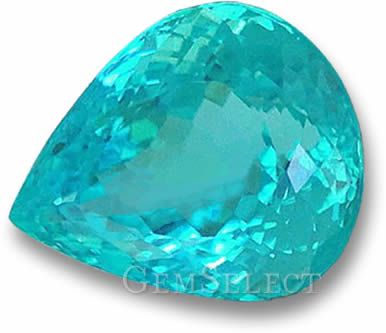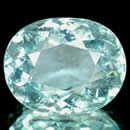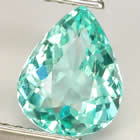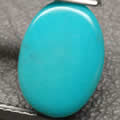Copper-bearing Gemstones
When Paraiba tourmaline first reached the market in the early 1990s, it led to a tremendous interest in copper-bearing gemstones. We receive many emails from customers asking whether particular gems in our inventory are copper-bearing. There seems to be a perception in the market that a gem containing traces of copper is inherently valuable. Is this a reasonable assumption?

Paraiba Tourmaline Gemstone
Copper is a particularly valuable mineral. The average American home is said to contain over 400 pounds of copper - in the plumbing, wiring, appliances, cookware and so on. So if you really want copper you don't need to leave home to find it. Your home is significantly copper-bearing, as are the coins in your pocket.
 With regard to minerals, there are about 160 different ones that contain copper. Indeed, there are also various gemstone-grade minerals to choose from. They include malachite, azurite, turquoise, chrysocolla, gem silica (chyrsocolla chalcedony quartz), larimar, Oregon sunstone and, of course, Paraiba tourmaline. With regard to minerals, there are about 160 different ones that contain copper. Indeed, there are also various gemstone-grade minerals to choose from. They include malachite, azurite, turquoise, chrysocolla, gem silica (chyrsocolla chalcedony quartz), larimar, Oregon sunstone and, of course, Paraiba tourmaline.
 Many of these copper-bearing minerals are quite inexpensive. We sell attractive turquoise for less than three dollars per carat. Azurite is even cheaper, though lapis lazuli is usually preferred for its better color and hardness. Chrysocolla, another soft and inexpensive gemstone, is even cheaper than turquoise. Many of these copper-bearing minerals are quite inexpensive. We sell attractive turquoise for less than three dollars per carat. Azurite is even cheaper, though lapis lazuli is usually preferred for its better color and hardness. Chrysocolla, another soft and inexpensive gemstone, is even cheaper than turquoise.
In fact the only truly expensive copper-bearing gemstone is Paraiba tourmaline. Since there are lots of other copper-bearing gems, why is Paraiba tourmaline so pricey? It can't be just because it is copper-bearing.
Paraiba tourmaline is valuable because of its unique and outstanding color, and the fact that it is extremely rare. It wouldn't matter how much copper it contained if it didn't have that neon blue-green glow.
 Isn't it precisely because Paraiba tourmaline contains copper that it has that outstanding color? Well, yes and no. The distinctive blue-green color is characteristic of copper oxide. That's why turquoise has its wonderful color, and this is also why the largest copper structure in the world, the Statue of Liberty in New York, has acquired a marvelous green patina. However, Paraiba tourmaline is not only colored by copper, it is also colored by traces of manganese. Gemologists believe that the combination of copper and manganese is responsible for Paraiba tourmaline's unusually vivid color. Isn't it precisely because Paraiba tourmaline contains copper that it has that outstanding color? Well, yes and no. The distinctive blue-green color is characteristic of copper oxide. That's why turquoise has its wonderful color, and this is also why the largest copper structure in the world, the Statue of Liberty in New York, has acquired a marvelous green patina. However, Paraiba tourmaline is not only colored by copper, it is also colored by traces of manganese. Gemologists believe that the combination of copper and manganese is responsible for Paraiba tourmaline's unusually vivid color.
It's also worth keeping in mind that Paraiba tourmaline is the only transparent gemstone that contains copper. Other copper-bearing gems, such as turquoise, have that lovely blue-green characteristic of copper, but the effect is quite different in an opaque gem.
 The majority of the currently (2024) available Paraiba tourmaline in the market originates from Mozambique, which is also known for producing a diverse range of impressive tourmaline colors. It is important not to assume that all tourmaline from Mozambique is the highly valuable copper-bearing variety. The exceptional value of certain tourmaline lies in its vibrant Paraiba color, rather than solely the presence of copper in its composition. Pink, green, or red tourmaline from Mozambique is unlikely to contain copper, and even if it did, the presence of copper would not enhance the gem's value, as these colors are not particularly rare. The majority of the currently (2024) available Paraiba tourmaline in the market originates from Mozambique, which is also known for producing a diverse range of impressive tourmaline colors. It is important not to assume that all tourmaline from Mozambique is the highly valuable copper-bearing variety. The exceptional value of certain tourmaline lies in its vibrant Paraiba color, rather than solely the presence of copper in its composition. Pink, green, or red tourmaline from Mozambique is unlikely to contain copper, and even if it did, the presence of copper would not enhance the gem's value, as these colors are not particularly rare.
|
